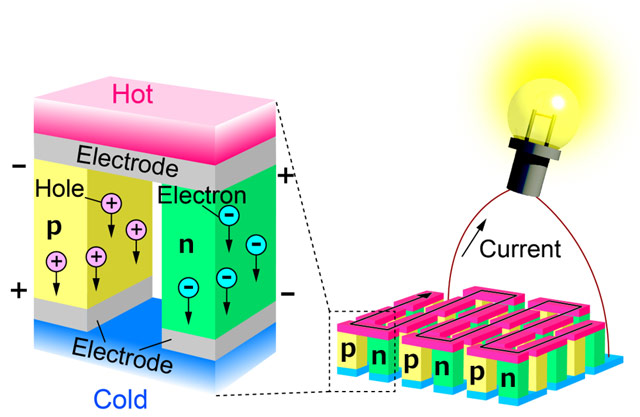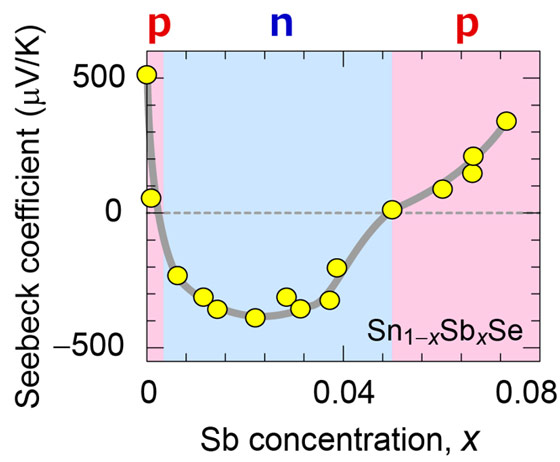Scientists at Tokyo Institute of Technology (Tokyo Tech) demonstrate double charge carrier type switching of tin monoselenide (SnSe) semiconductor by doping of antimony (Sb). The SnSe carrier type switches from p-type to n-type, and re-switches to p-type as doping increases, due to the switching of major Sb substitution site from Se to Sn, promising reliable charge polarity control, leading to realization of SnSe-based p/n homojunction thermoelectric device for converting waste heat into electricity and new insights on impurity doping of compound semiconductors.
In recent years, the energy consumption in developed countries has been rather wasteful. Nearly two-thirds of the total energy is typically discarded into the environment as "waste heat," which ends up contributing to global warming. Finding a way to productively use this heat has been at the forefront of every material researcher's priority.
One of the various possible ways to recover this waste heat as electricity is using what is known as "thermoelectric conversion"—a process that uses temperature difference in semiconductors to directly convert into electric voltage. Thermoelectric devices include p-type and n-type semiconductors with two types of charge carriers, i.e. electron and hole. The p-type and n-type semiconductors are connected in series to produce a large thermoelectric voltage (Figure 1). Therefore, it is necessary to develop the both p-type and n-type semiconductors with high thermoelectric conversion efficiency.

Figure 1. Thermoelectric device that converts waste heat into electricity
Tin monoselenide (SnSe), when doped with antimony (Sb), can make for a suitable candidate for the design of thermoelectric conversion elements (p-n junction device).
One particular semiconductor material that scientists have recently turned their attention to is tin monoselenide (SnSe), which reportedly exhibits the world's highest thermoelectric conversion performance index ZT value. However, SnSe is incapable of controlling the charge carrier type with ease. Doping with alkali ions improves p-type thermoelectric performance but the alkali ions are volatile and diffusive elements, and are not suitable for high-temperature applications. Adding bismuth and iodine to make it n-type, on the other hand, results in low electron concentrations.
In a new study published in Advanced Functional Materials, a team of scientists from Tokyo Tech, Japan, led by Prof. Takayoshi Katase discovered that when doped with antimony (Sb), SnSe, denoted as (Sn1-xSbx)Se, exhibits a peculiar switching of conduction type. Specifically, the team observed that at low doping concentrations, (Sn1-xSbx)Se started out with p-type conduction but switched to n-type with increasing doping, and finally switched back to p-type for high concentrations (see Figure 2). The elaborate analyses and calculations revealed an interesting charge type switching mechanism which, the team found, has to do with the distribution of Sb substitution sites between Sn and Se. They attributed this switching behavior to a switching of major Sb substitution site from Se (SbSe) to Sn (SbSn) with increasing doping.

Figure 2. Change in thermoelectromotive force (Seebeck coefficient) with addition of Sb impurity to SnSe
SnSe starts out with p-type conduction at low Sb concentrations (






